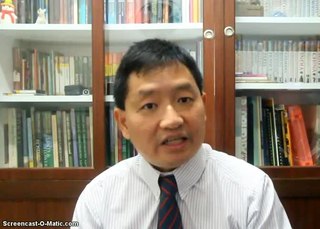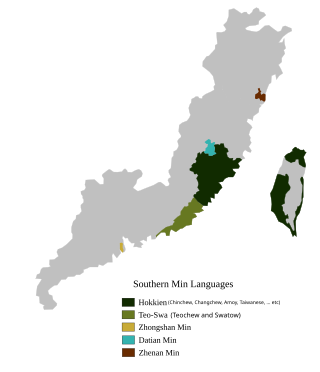Related Research Articles

Standard Chinese is a modern standardized form of Mandarin Chinese that was first codified during the Republican Era (1912‒1949). It is designated as the official language of mainland China and a major language in the United Nations, Singapore, and Taiwan. It is largely based on the Beijing dialect. Standard Chinese is a pluricentric language with local standards in mainland China, Taiwan and Singapore that mainly differ in their lexicon. Hong Kong written Chinese, used for formal written communication in Hong Kong and Macau, is a form of Standard Chinese that is read aloud with the Cantonese reading of characters.
Manglish is an informal form of Malaysian English with features of an English-based creole principally used in Malaysia. It is heavily influenced by the dominant languages of the country, Malay, Chinese languages, and Tamil. It is not an official language of Malaysia.
Singapore English is the set of varieties of the English language native to Singapore and Malaysia. In Singapore, English is spoken in two main forms: Singaporean Standard English and Singapore Colloquial English.

The grammar of Standard Chinese shares many features with other varieties of Chinese. The language almost entirely lacks inflection; words typically have only one grammatical form. Categories such as number and verb tense are often not expressed by grammatical means, but there are several particles that serve to express verbal aspect and, to some extent, mood.

Penang Hokkien is a local variant of Hokkien spoken in Penang, Malaysia. It is spoken natively by 63.9% of Penang's Chinese community, and also by some Penangite Indians and Penangite Malays.

Chinese Singaporeans are Singaporeans of Han Chinese descent. Chinese Singaporeans constitute 75.9% of the Singaporean citizen population according to the official census, making them the largest ethnic group in Singapore.

The Fuzhou dialect, also Foochow, Hokchew, Hok-chiu, or Fuzhounese, is the prestige variety of the Eastern Min branch of Min Chinese spoken mainly in the Mindong region of Eastern Fujian Province. As it is mutually unintelligible to neighbouring varieties in the province, under a technical linguistic definition Fuzhou is a language and not a dialect. Thus, while Fuzhou may be commonly referred to as a 'dialect' by laypersons, this is colloquial usage and not recognised in academic linguistics. Like many other varieties of Chinese, the Fuzhou dialect is dominated by monosyllabic morphemes that carry lexical tones, and has a mainly analytic syntax. While the Eastern Min branch it belongs to is relatively closer to other branches of Min such as Southern Min or Pu-Xian Min than to other Sinitic branches such as Mandarin, Wu Chinese or Hakka, they are still not mutually intelligible.
Cantonese is an analytic language in which the arrangement of words in a sentence is important to its meaning. A basic sentence is in the form of SVO, i.e. a subject is followed by a verb then by an object, though this order is often violated because Cantonese is a topic-prominent language. Unlike synthetic languages, seldom do words indicate time, gender and number by inflection. Instead, these concepts are expressed through adverbs, aspect markers, and particles, or are deduced from the context. Different particles are added to a sentence to further specify its status or intonation.

Sichuanese or Szechwanese (simplified Chinese: 四川话; traditional Chinese: 四川話; Sichuanese Pinyin: Si4cuan1hua4; pinyin: Sìchuānhuà; Wade–Giles: Szŭ4-ch'uan1-hua4), also called Sichuanese/Szechwanese Mandarin (simplified Chinese: 四川官话; traditional Chinese: 四川官話; pinyin: Sìchuān Guānhuà), is a branch of Southwestern Mandarin spoken mainly in Sichuan and Chongqing, which was part of Sichuan Province until 1997, and the adjacent regions of their neighboring provinces, such as Hubei, Guizhou, Yunnan, Hunan and Shaanxi. Although "Sichuanese" is often synonymous with the Chengdu-Chongqing dialect, there is still a great amount of diversity among the Sichuanese dialects, some of which are mutually unintelligible with each other. In addition, because Sichuanese is the lingua franca in Sichuan, Chongqing and part of Tibet, it is also used by many Tibetan, Yi, Qiang and other ethnic minority groups as a second language.
Malaysian Mandarin (simplified Chinese: 马来西亚华语; traditional Chinese: 馬來西亞華語; pinyin: Mǎláixīyà Huáyǔ; Wade–Giles: Ma3-lai2-hsi1-ya4 Hua2-yü3) is a variety of Mandarin Chinese spoken in Malaysia by ethnic Chinese in Malaysia. Today, Malaysian Mandarin is the lingua franca of the Malaysian Chinese community.
Singlish is the English-based creole or patois spoken colloquially in Singapore. English is one of Singapore's official languages, along with Malay, Mandarin, and Tamil. Although English is the lexifier language, Singlish has its unique slang and syntax, which are more pronounced in informal speech. It is usually a mixture of English, Hokkien, Cantonese, Malay, and Tamil, and sometimes other Chinese languages like Teochew, Hainanese, Hakka, Hockchew, and Mandarin. For example, pek chek means to be annoyed or frustrated, and originates from Singaporean Hokkien 迫促. It is used in casual contexts between Singaporeans, but is avoided in formal events when certain Singlish phrases may be considered unedifying. Singapore English can be broken into two subcategories. Standard Singapore English (SSE) and Colloquial Singapore English (CSE) or Singlish as many locals call it. The relationship between SSE and Singlish is viewed as a diglossia, in which SSE is restricted to be used in situations of formality where Singlish/CSE is used in most other circumstances.

The Amoy dialect or Xiamen dialect, also known as Amoynese, Amoy Hokkien, Xiamenese or Xiamen Hokkien, is a dialect of Hokkien spoken in the city of Xiamen and its surrounding metropolitan area, in the southern part of Fujian province. Currently, it is one of the most widely researched and studied varieties of Southern Min. It has historically come to be one of the more standardized varieties.
Singaporean Mandarin is a variety of Mandarin Chinese spoken natively in Singapore. It is one of the four official languages of Singapore along with English, Malay and Tamil.
Singaporean Hokkien is a local variety of the Hokkien language spoken natively in Singapore. Within Chinese linguistic academic circles, this dialect is known as Singaporean Ban-lam Gu. It bears similarities with the Amoy spoken in Amoy, now better known as Xiamen, as well as Taiwanese Hokkien which is spoken in Taiwan.
Colloquial Singaporean Mandarin, commonly known as Singdarin or Singnese, is a Mandarin dialect native and unique to Singapore similar to its English-based counterpart Singlish. It is based on Mandarin but has a large amount of English and Malay in its vocabulary. There are also words from other Chinese languages such as Cantonese, Hokkien and Teochew as well as Tamil. While Singdarin grammar is largely identical to Standard Mandarin, there are significant divergences and differences especially in its pronunciation and vocabulary.

Hokkien is a variety of Chinese. It is a Southern Min language native to and originating from the Minnan region, in the southeastern part of Fujian in southeastern mainland China. It is also referred to as Quanzhang, from the first characters of the urban centers of Quanzhou and Zhangzhou.

Singlish ; formally known as Colloquial Singaporean English, is an English-based creole language originating in Singapore. Singlish arose out of a situation of prolonged language contact between speakers of many different Asian languages languages in Singapore, such as Malay, Cantonese, Hokkien, Mandarin, Teochew, and Tamil. The term Singlish is a blend of Singaporean slang and English and was first recorded in the early 1970s.
The Fuqing dialect, or Hokchia, is an Eastern Min dialect. It is spoken in the county-level city of Fuqing, China, situated within the prefecture-level city of Fuzhou. It is not completely mutually intelligible with the Fuzhou dialect.
Standard Singaporean Mandarin is the standard form of Singaporean Mandarin. It is used in all official Chinese media, including all television programs on Channel 8 and Channel U, various radio stations, as well as in Chinese lessons in all Singapore government schools. The written form of Chinese used in Singapore is also based on this standard. Standard Singaporean Mandarin is also the register of Mandarin used by the Chinese elites of Singapore and is easily distinguishable from the Colloquial Singaporean Mandarin spoken by the general populace.
Huayu (华语) is an alternative name of Standard Chinese, used in parts of Southeast Asia.